Indian Eagle Owl (bubo bubo bengalensis)
Indian Eagle Owl (bubo bubo bengalensis) is a sub-species of Eurasian Eagle owl found across India.
This is one of the largest of the owls and its wingspan is around 3.5 ft. It was "love at first sight" when I first spotted this inside Chennai.
A small reserved forest inside the city has some abandoned quarries. The perfect place for Eagle Owls to stay. The bird gets camouflaged too well with the rocky ledges and is very difficult to spot.
But, once spotted they hook their eyes on you and it would be scary to look at them. They also give a lot of funny expressions once they get used to and relax in front of the cameras.
The below images have been made over a course of time showing different expressions and few moments from owls life.
Thanks to my friends Nara, GK, Anand, Shriram who have accompanied me on various visits to this place to get the below images.
Equipment: Canon 5D M2, Canon 300mm F4, Canon 1.4TC, Manfrotto Tripod.
The 'indian eagle owl' is well camouflaged to its surroundings. Every time we visited, we had to spend time to find them and most of the time we had lost in this 'hide and seek' game and the owl would come back from its hiding with a winning smile looking at us.
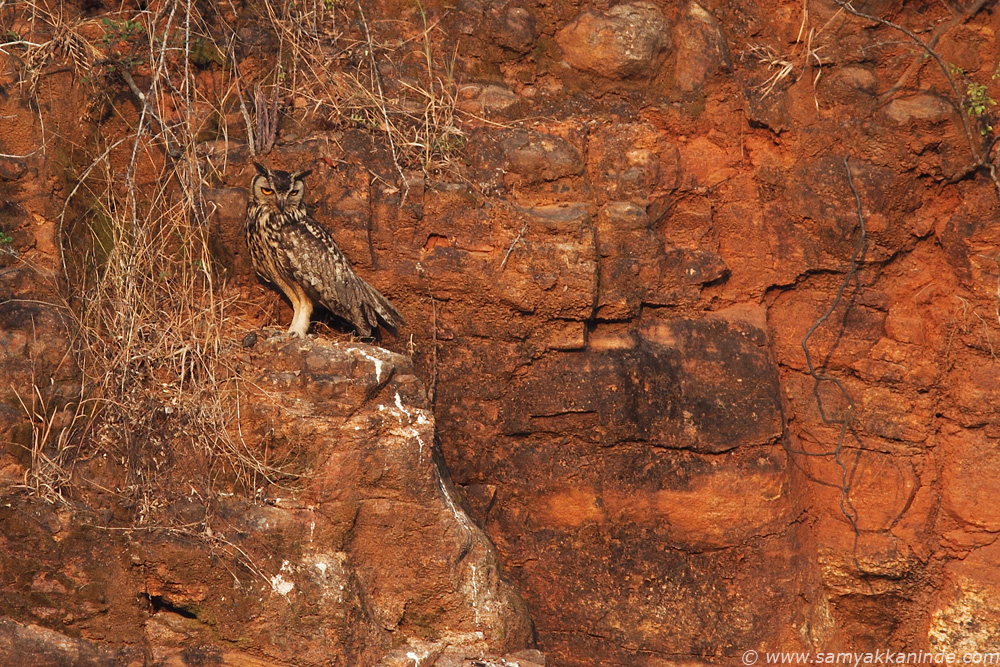
Most of the times, when we were unable to spot the owl, we were helped by the crows to find them. We would just wait until the crows gather with the first ray of light at the quarry. Once they are in good numbers, they warm themselves up for the day by playing with the owl chicks. They would fly all around them, teasing them, poking them, but owls would just watch crows with a yawn. Such a gentleman of the species. My respect towards them was grown a lot due to their patience to tolerate this nuisance daily. I wish, we humans have this patience to fight our daily nuisances.
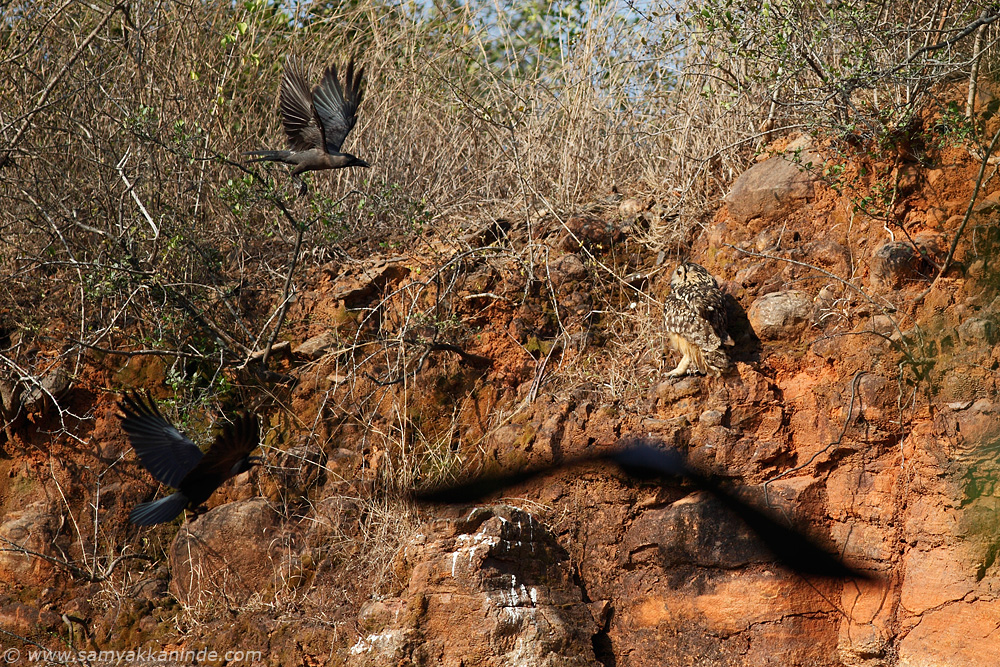
The crows would gather around the lone juvenile while its parents would be sitting at different places. they would slowly jump around him, go near him, poke him and fly off. The crows are perfect mobs. No one would do anything alone. If they get a backup, they start teasing around. A juvenile owl is watching a crow sitting near him carefully, but its calm and cool.
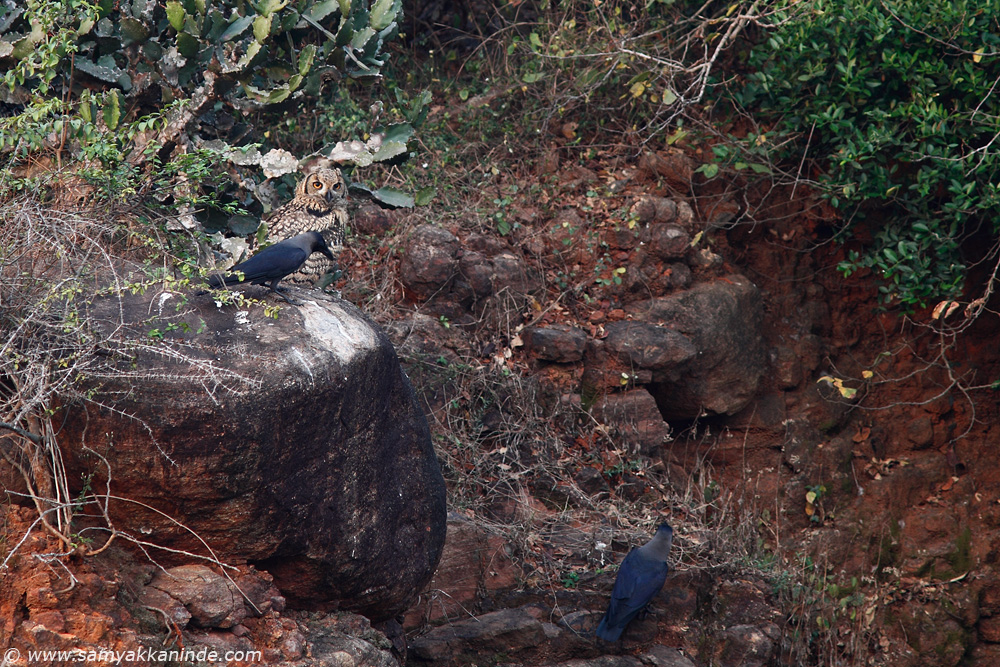
This was the favourite spot of my owl probably due to the sunrise hitting here the first. It was also more spacious compared to its other sitting spots. The disadvantage was this spot also has a tree on the ledge and it was perfect for crows to come and sit there before launching attacks on these owls. Here you can see how the crows are mobbing the poor juvenile owl while it just is watchful but no return attack.
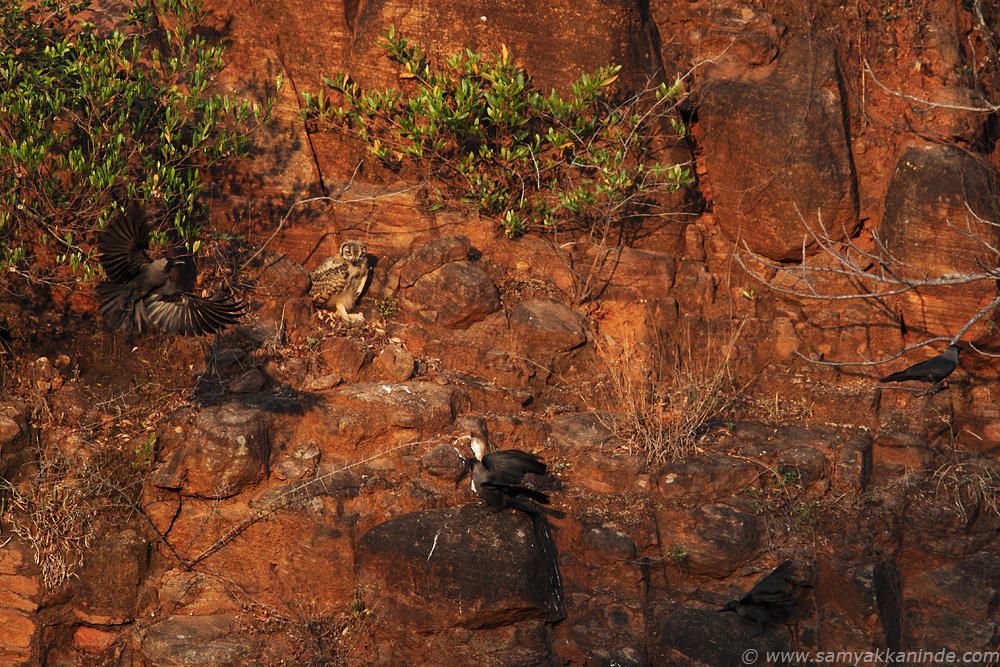
Sometimes, the crows would be successfully able to chase away the parent owl. Juveniles would just go in hiding. The owl would have been getting bored by constant mobbing and decide to go back in thick bushes for resting through the day. Here, as you can see a size difference between the crow and eagle owl. The owls are much larger than crows and still do not bother about their constant nagging.
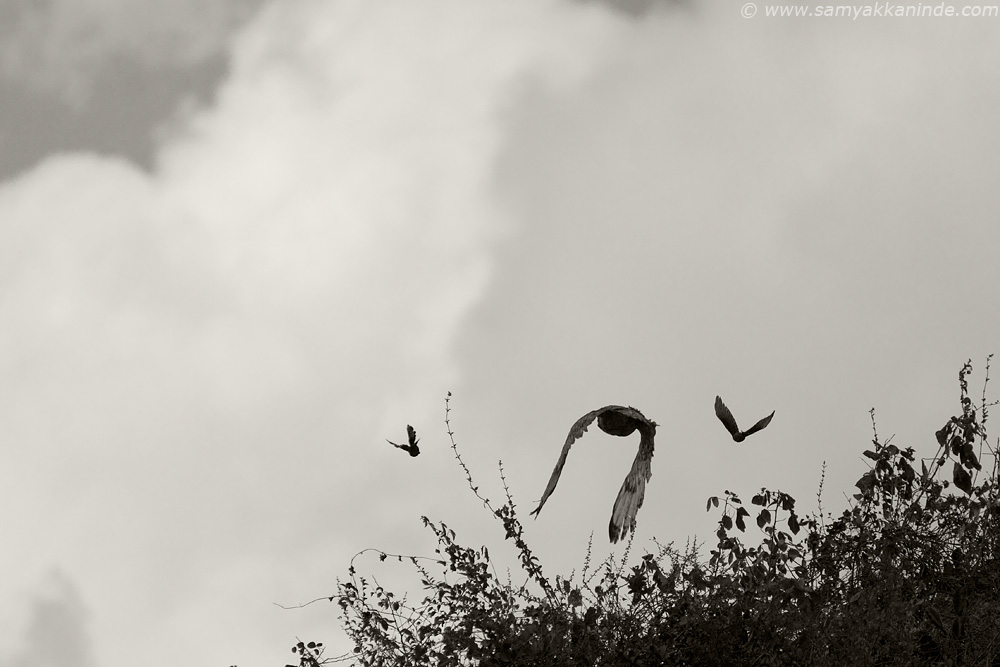
In all my visits, I have seen that the two juveniles would never be together. Here, they were together sitting but just for a minute. The next moment, the other juvenile started chasing away the sibling out of that place. As seen here, the juvenile in the back is pulling up the feather of the sibling while putting his leg on its back. The juveniles would start taking short flights around the nesting place in around 35 days. So, these juvs were definitely a month and a little more old.
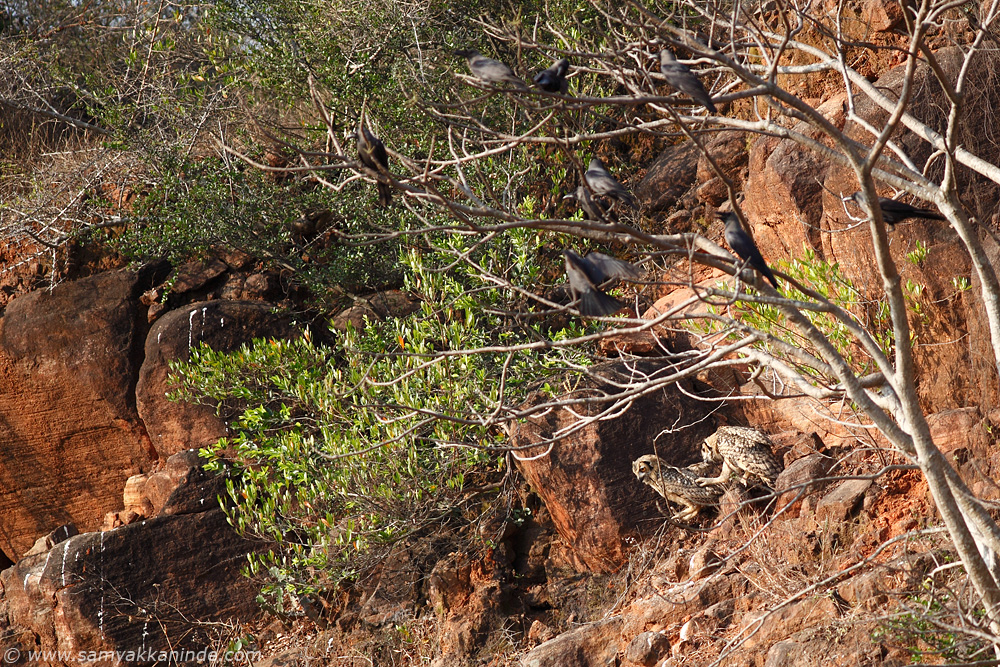
After chased by the sibling, the juvenile joined its mother at this small place. After getting unconfirtable as such small place, the juvenile started poking at mother and the mother has to leave the place. The juvenile with big eyes is watching its mother take off form the place.
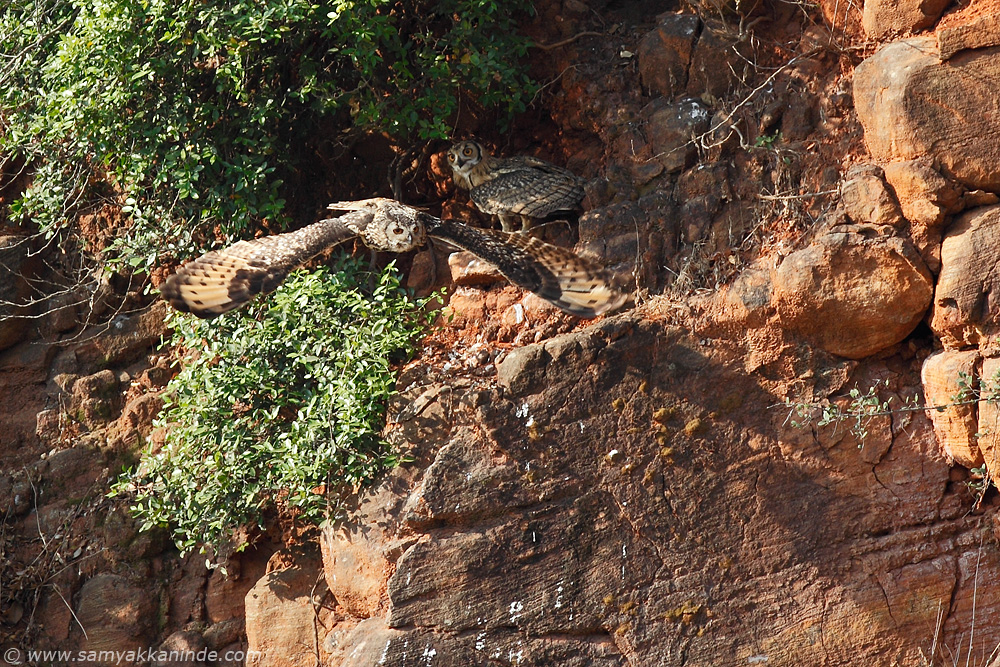
The owls were not just perfect camaflouge for thier rocky surroundings but they were also pretty much good in hiding out. Here, if you strain your eyes a little, you can see that one juvenile is just trying to hide behind a rock in a shade. Imaging spotting this in a larger scene with no help and clue.
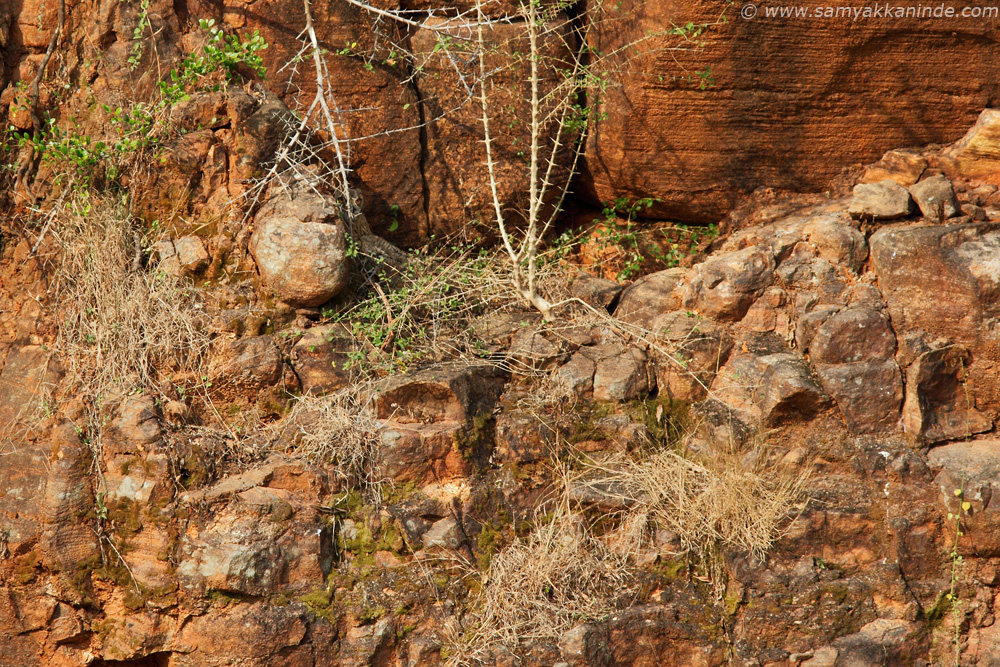
Like other owls, the eagle owls also are nocturnal owls and spend their day time resting in shades until the dusk. Being a hunter in the nights, they are helped by the large eyes which has a binacular like vision and can look pretty well for the prey such as rodents, mice and also roosting birds at night.
The juvenile here is resting while its mother is nearby keeping a watch on their safety and taking a look at the nagging crows which are disturbing them.
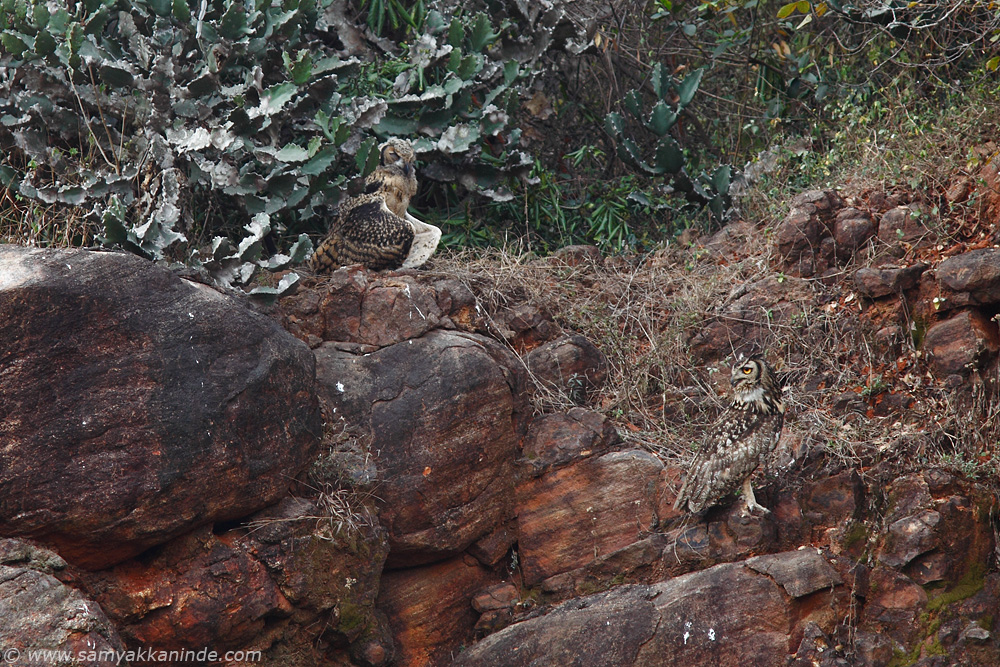
As the owls went to rest, crows left the scene, we were also resting watching other insects, damselflies around. Suddenly, we heard a large repeatative "tu-whoooh" call. This is the call of the eagle owl whih we were hearing for the first time. It was repeatative, and growing loud. The two juveniles were woken up from their sleeps, the parents were rigorously calling and we were amazed and eager to know whats going on. Suddently, we saw a big rat snake emerging from the creeks of the rock below. The snake unfortunately decided to move upwards where the owls were sitting. The mother could not take it, and after repeatative calls, launched an attack on this huge snake. The juvenile is sitting their watching its parent take a battle with the snake.
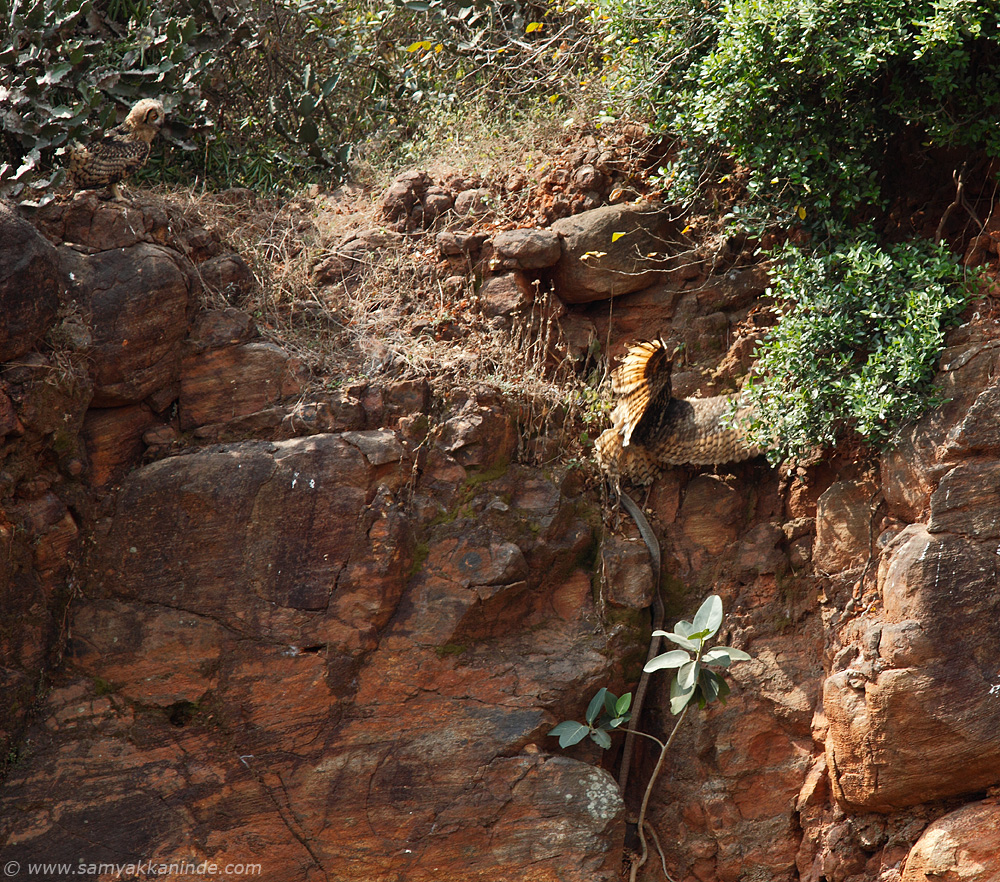
After scaring the snake by direct attack, the owl kept roaming overhead of the snake until the snake realised its mistake. Firstly, I thought it would take the snake as its prey and would kill it. But, it just let it go after the severe warning. The snake was quite long and big for it to be a prey, and moreover, the owl would have not been hungry. could be !!
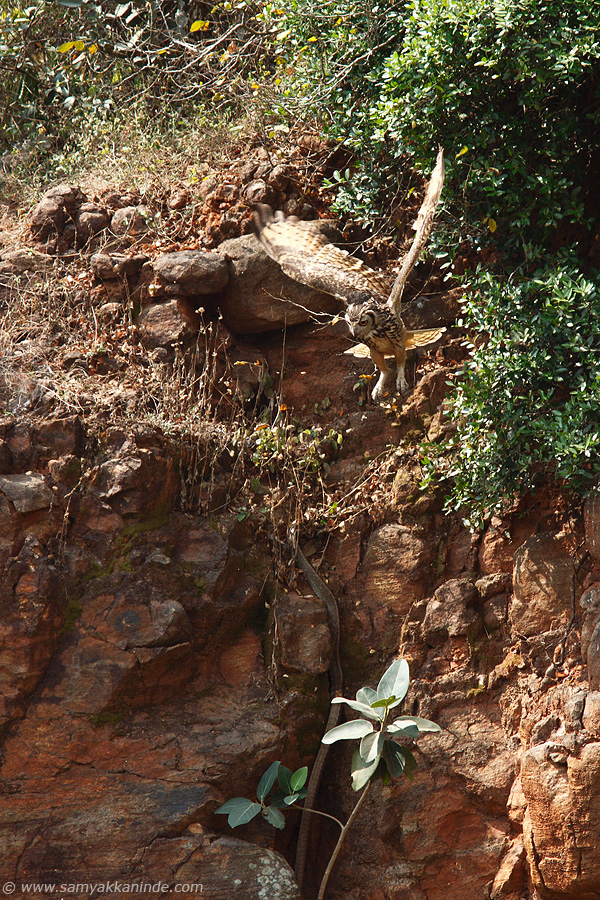
The snake retracted backwards and the owl left the place and flew back in shade near its juvenile and rested. There were few more "tu-whooo" calls to convey "all is well" I supoose and things were back to normal. The snake disappeared in front of us back into rocky creeks.
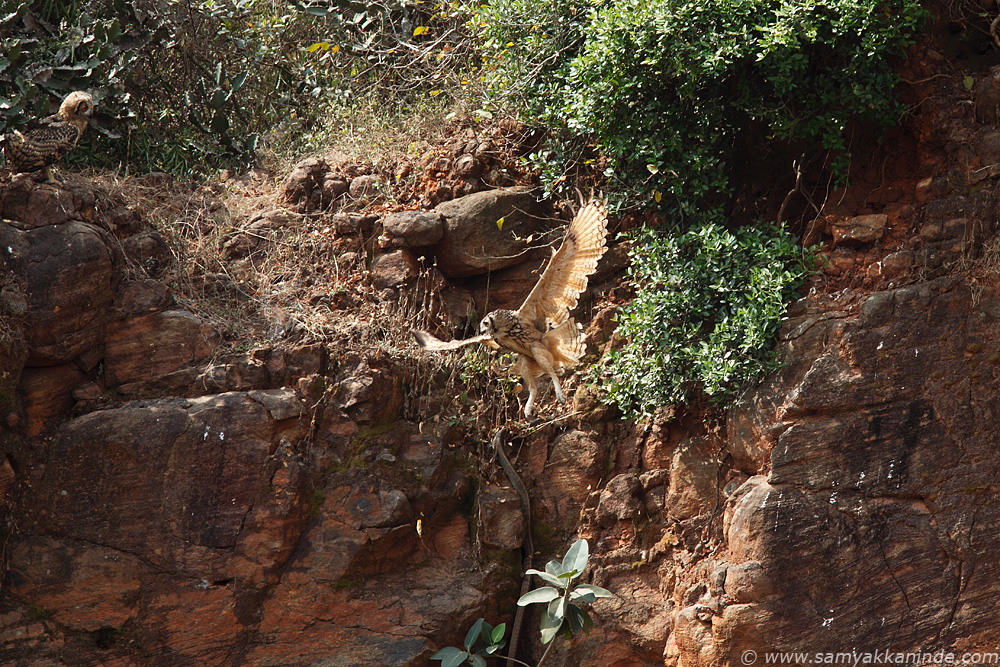
The female takes care of incubating eggs while the male brings the food to the nest. Even after hatching, its the male who would bring food for chicks and their mother at the nest site. As seen here, there is a big rodent (black patch) in front of the male owl sitting below. While the juvenile, looks not hungry or interested in eating that one. The crows were chasing it around and were attacking, so the owl just took off with the rodent it had and went to a different place and ate it itself.
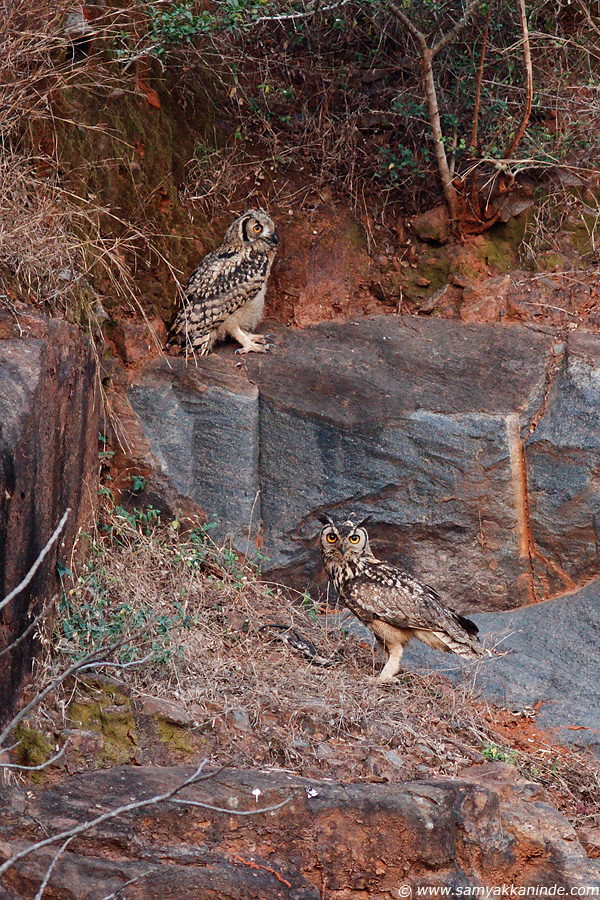
The owl would be constantly watching us at all the times. If it had to change the position, it would patiently wait until we take our eyes off it. We would just look aorund, review pictures on LCD, and it would take off. Once it changes its place and if not tracked, it would again become very difficult to spot it and find out where it landed. Here its landing on another rock and almost camaflouged with the rock to see where its flying.
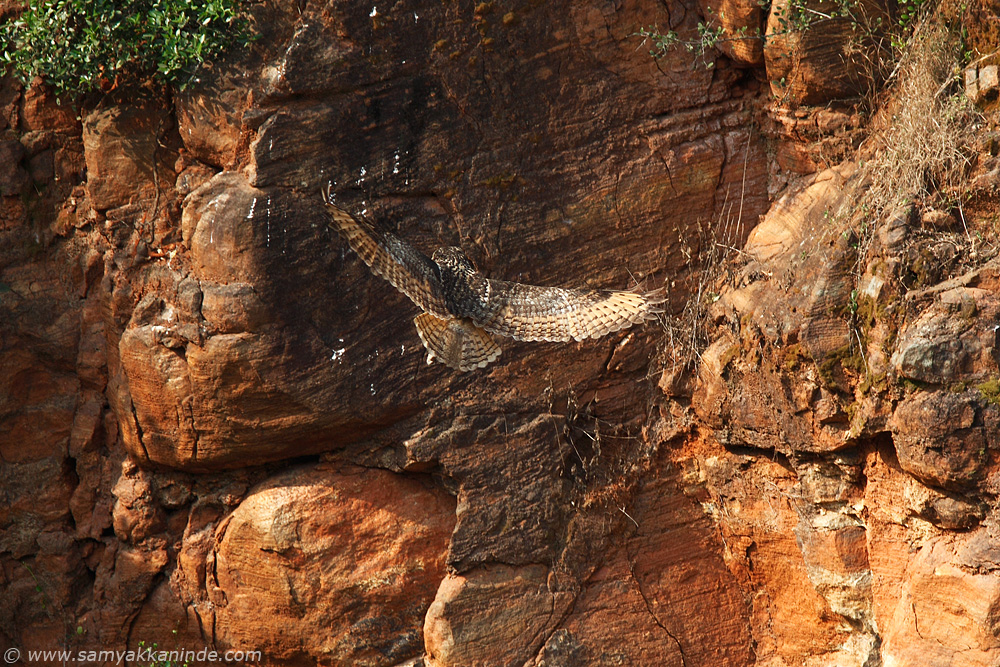
The owl with its huge wingspan and flights is known for its ability to not make any whooshing sound of its wings while taking off, flying. This would always make it difficult to know when the bird changes its place and disappear.
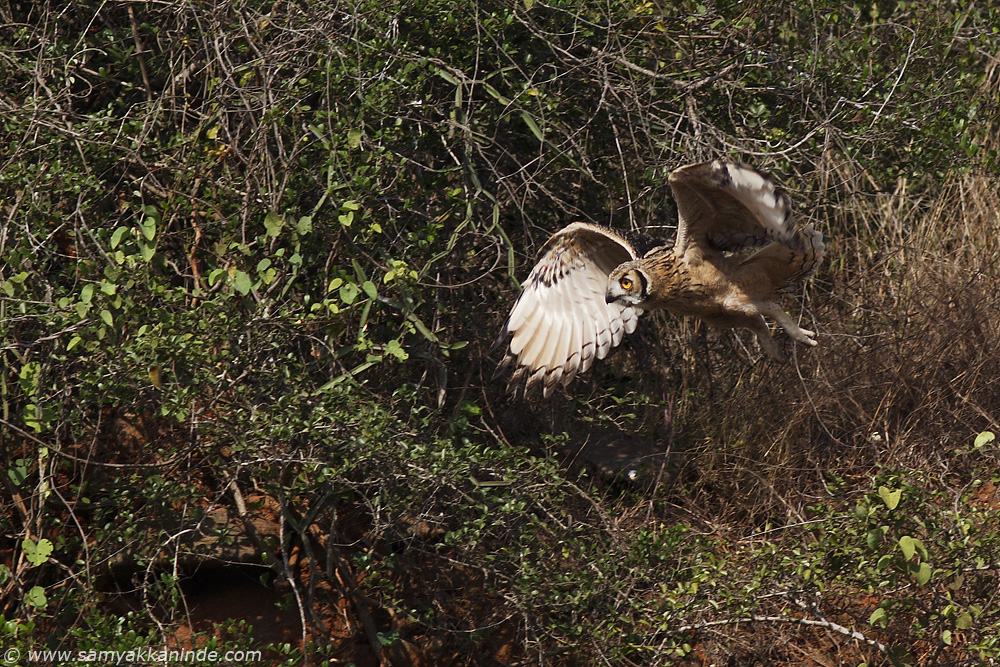
The grabbing stance to hold on to the prey/rock. This eagle owl was about to land on the rock nearby and it brought forward its open wings almost breaking instantly and opening up its talons in grabbing position to hold onto the rock.
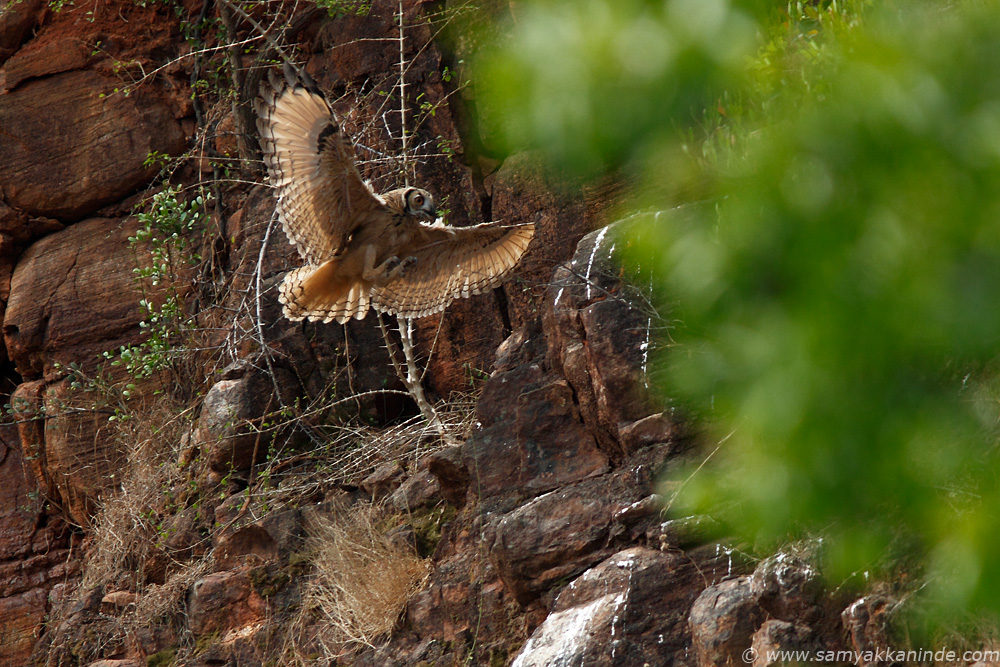
Flying away to change its place.
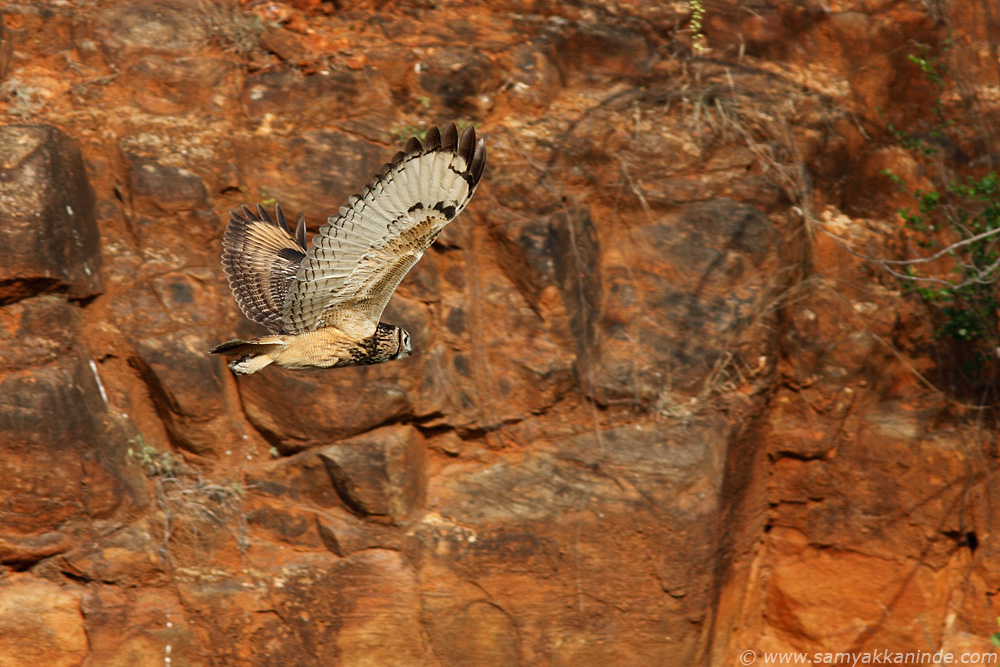
The eagle owls have a broader wings and designed in such a way that, they can glide with minimum flapping of wings. This results in the minimum noise while flying and it helps them to go and grab the prey almost making no noise while approaching it.
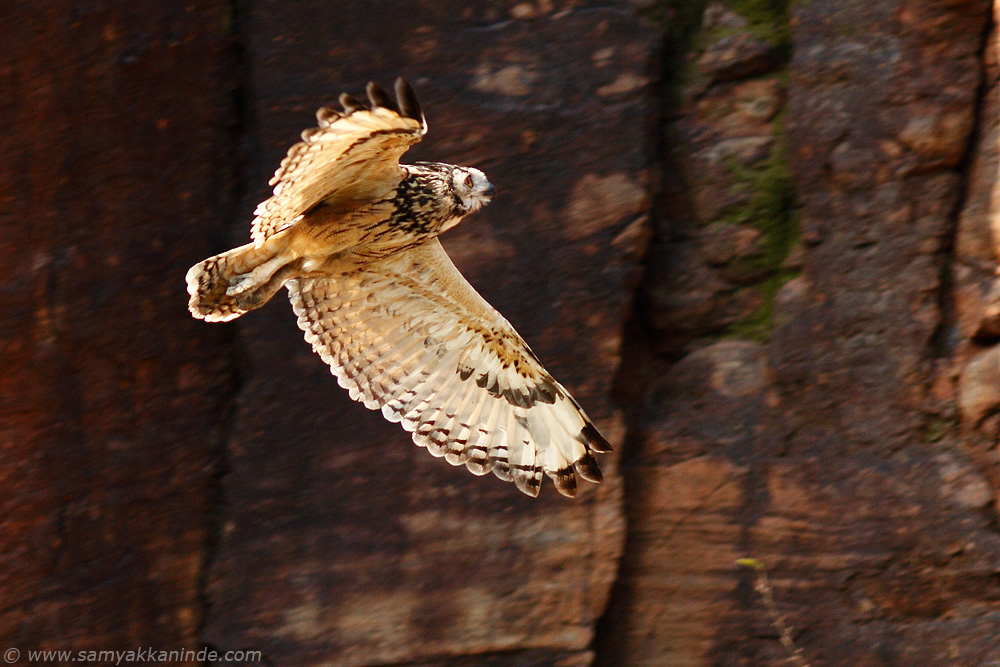
The portrait in rising sun light. The sunrays would first hit this ridge in the morning. For once, I was blessed, for that awesome stance and fixed stare at my camera by this owl giving me a portrait of itself in best of the light. Don't forget to look back its powerful legs and long talons which would tear apart the flesh from its prey easily.
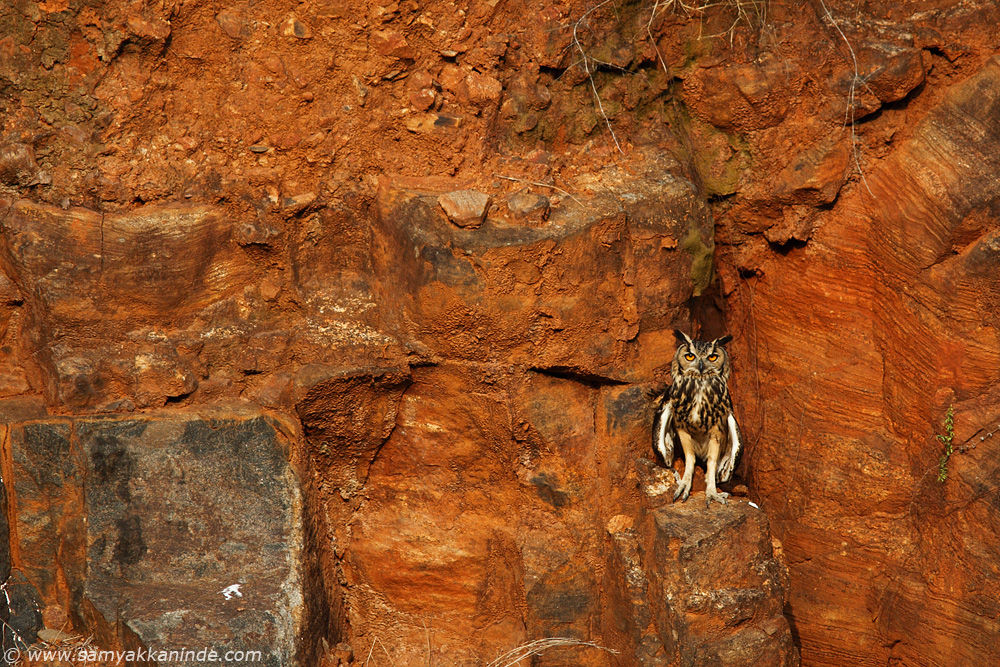
The owl family portrait. I have never seen all of them together at one place. But, once I was blessed to see them at least in one single frame sitting nearby each other.
The female at the right top, juvenile, male and juvenile again. Can you see all of them?

Threats : The owls in india face challenge in living not from anything else but humans. Owls are killed for various reasons, superstition amongst humans is one of the biggest. The indian eagle owl is supposed to be beaten up badly and known to speak like humans that can predict the future. They are also killed as their calling of "tu-whooo" is supposed to be ominous and is a sign of a death in the house.
After birdwatching for a year and more, owls are still my favourite birds to sit and observe for their elegance, facial expressions and moreover the patient behaviour to the nagging crows.
Disclaimer : While shooting these pictures, utmost care was taken to not disturb the owls or force them for flying around for pictures. The pictures were taken form another ridge opposite to it and owls were never approached to go nearby. The quarry is frequented by locals all the time (for shitting, swimming, drinking). If you happen to go there to watch these owls, please maintain peace and make sure you are not disturbing them by trying to go too close.




